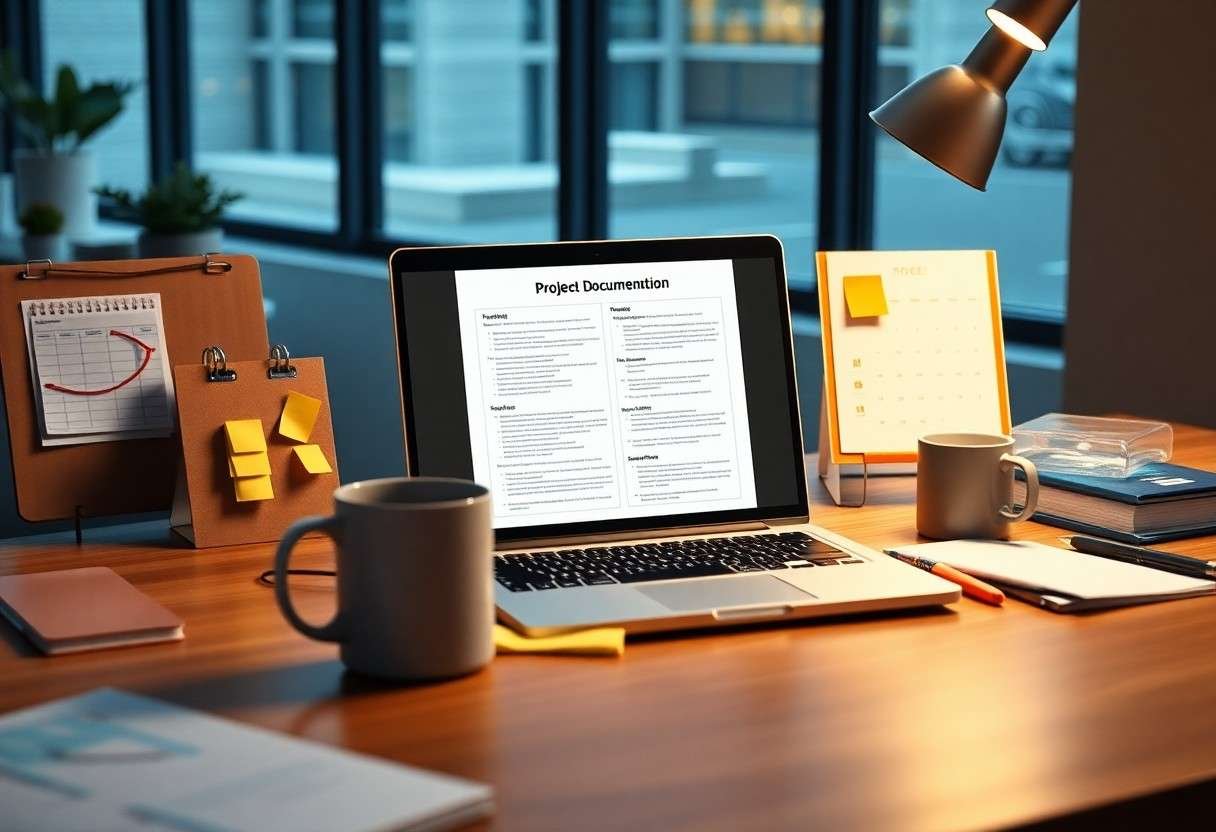Best practices in project documentation can significantly enhance your project’s success and efficiency. In this guide, I will share insightful techniques to help streamline your documentation process and ensure that everyone is on the same page. By implementing these best practices, you’ll reduce the risks of miscommunication and boost your team’s productivity. Whether you’re managing a small project or a large-scale endeavor, having structured and clear documentation is vital for navigating challenges. Let’s examine the details that will elevate your project management skills.
Key Takeaways:
- Clarity: Ensure that all documentation is clear and free of jargon to facilitate understanding across all team members.
- Accessibility: Store documents in a centralized location to allow easy access for all stakeholders, promoting collaborative efforts.
- Consistency: Use standardized templates and terminology throughout project documentation to maintain uniformity and reduce confusion.
- Version Control: Implement versioning for documents to track changes and maintain the integrity of information as it evolves.
- Regular Updates: Schedule periodic reviews and updates of documentation to ensure that it remains relevant and reflective of the current project status.
Types of Project Documentation
The types of project documentation are important for a successful project. Here’s a breakdown of the main types:
| Project Plans | Outline of the project scope, objectives, and approach. |
| Status Reports | Updates on project progress, milestones, and challenges. |
| Meeting Notes | Summary of discussions, decisions, and actions from meetings. |
| User Manuals | Guides intended for users on how to utilize the project outcomes. |
| Requirements Documents | Specification of project needs and expectations. |
The documentation plays a vital role in facilitating communication and ensuring all stakeholders are aligned.
Project Plans
Assuming you have a clear vision, the project plan serves as your roadmap. It details the project’s goals, deliverables, and schedule. A well-crafted plan will guide you through the various stages of development while allowing for adjustments as needed.
Status Reports
Some of the most important documentation consists of status reports, which keep everyone informed about the progress of your project. These reports should include key milestones achieved, current challenges, and any adjustments to timelines or resources.
Project status reports help in maintaining transparency, enabling your team and stakeholders to evaluate the project’s health continuously. By regularly sharing these updates, I find that it fosters trust and encourages proactive solutions to any issues that arise.
Meeting Notes
Clearly, meeting notes are integral to project documentation. These notes capture key points, decisions made, and action items discussed during meetings, ensuring accountability and continuity among team members.
Status updates from these meetings not only help track project milestones but also serve as a reference for future discussions, aiding in minimizing misunderstandings and enhancing collaboration.
User Manuals
For effective implementation, user manuals are important resources that guide users through the functionalities of your product or project outcomes. A well-structured manual enhances user experience and satisfaction.
User manuals should be clear and concise, ensuring that users can easily navigate through features or troubleshooting steps. By providing comprehensive manuals, I support users in maximizing the value of the solutions you provide.
Tips for Effective Documentation
It is imperative to create effective documentation that enhances understanding and usability. Here are some tips to follow:
- Use clear language that is easily understood
- Maintain consistency in style and format throughout
- Incorporate actionable details for better clarity
- Utilize templates to standardize documentation
- Engage with audience feedback to improve
Thou shall prioritize clarity in every aspect of your documentation.
Clarity and Conciseness
Tips for achieving clarity and conciseness include avoiding jargon and using simple, direct language. Always get to the point quickly, so your audience doesn’t lose interest. Be mindful of the length of your documentation; aim for succinctness while still conveying all the necessary information.
Visual Aids
The use of visual aids can significantly enhance the effectiveness of your documentation. Diagrams, charts, and images help convey complex information in a manner that is easy to digest and understand. They cater to visual learners and can make even intricate details more comprehensible.
Plus, integrating visual aids not only breaks the monotony of text but also increases engagement. Infographics can summarize large amounts of data, while flowcharts illustrate processes succinctly. By presenting information visually, you cater to various learning styles and enhance overall comprehension.
Regular Updates
Assuming your documentation is static can lead to misinformation and outdated processes. It is vital to schedule regular updates to ensure that all information remains relevant and accurate.
Documentation should be treated as a living entity that evolves with your project. Keeping it up-to-date not only ensures that users have access to the most current information but also reflects professionalism and commitment to quality. Regular revisions are imperative for maintaining trust with your audience, and they reinforce the value of your documentation effort.
Step-by-Step Guide to Documenting Projects
To effectively document projects, I recommend following a structured approach that encompasses all phases of your project lifecycle. The table below outlines key steps and their corresponding goals, ensuring that your documentation is both comprehensive and actionable.
| Planning Phase | Establish objectives and outline documentation needs. |
| Execution Phase | Collect and organize data as the project progresses. |
| Closing Phase | Finalize documentation and review project outcomes. |
Planning Phase
Little attention to planning can lead to gaps in your documentation process. Focus on creating a detailed outline that defines what needs to be documented, including project goals, stakeholder roles, and timelines.
Execution Phase
The execution phase is where documentation truly comes to life. I find it crucial to gather data consistently, making sure that all decisions, changes, and developments are recorded accurately for future reference.
Projects often evolve in unpredictable ways, which makes the execution phase vital for maintaining accurate documentation. Collaborate with your team to ensure that information is updated regularly, allowing you to capture important milestones and potential setbacks as they occur.
Closing Phase
Execution of the closing phase involves reviewing and finalizing all documents generated throughout the project. I emphasize the importance of a thorough review to ensure that lessons learned and success metrics are documented effectively.
Phase completeness is not just about tying up loose ends; it’s a valuable opportunity for reflective learning. Assess what worked and what didn’t, as this feedback will enhance your future projects, substantially improving your project documentation practices.
Key Factors Influencing Documentation Success
Your project documentation’s success hinges on several key factors, including:
- Clear objectives
- Regular updates
- Team collaboration
- Stakeholder engagement
- Proper tools and software
Thou must prioritize these elements to achieve optimal documentation results.
Team Collaboration
Collaboration among team members is vital for effective documentation. When everyone shares their insights and responsibilities, the quality and completeness of the documents improve significantly. Regular meetings and feedback loops help ensure that all perspectives are considered, leading to more robust and useful documentation.
Stakeholder Engagement
If you want your documentation to be successful, engaging stakeholders throughout the project is important. Their input ensures that key requirements and expectations are met, ultimately reflecting their needs.
Documentation plays a significant role in stakeholder engagement by keeping all relevant parties informed and involved in the process. When stakeholders contribute their perspectives, it leads to a more thorough understanding of the project’s direction and fosters trust between the team and the stakeholders. This involvement not only enhances the documentation’s relevance but also ensures that it effectively addresses the project’s objectives.
Tools and Software
You should invest time in selecting the right tools and software for documenting your projects. Tools that facilitate easy collaboration and version control enhance the documentation process.
Another important aspect is that the right tools streamline communication, maintain consistency, and allow for easier access to documentation across teams. Utilizing user-friendly software that features templates, file-sharing options, and integration with other platforms can significantly improve your team’s efficiency and overall project documentation quality.
Noteworthy Pros and Cons of Different Documentation Approaches
Not every documentation approach suits every project. Below, I’ve outlined some of the significant pros and cons of various methods to help you choose the best fit for your needs.
| Approach | Pros & Cons |
|---|---|
| Agile | Quick iterations vs. potential gaps in comprehensive details |
| Traditional | Thorough documentation vs. potential for outdated information |
| Formal | Standardized processes vs. lack of flexibility |
| Informal | Encourages collaboration vs. inconsistency in documentation |
| Hybrid | Combines strengths of both approaches vs. increased complexity |
| Visual | Enhances understanding vs. not suitable for all content |
| Text-Based | Detail-oriented vs. harder to navigate visually |
| Wikis | Easy updates vs. potential for misinformation |
| Online Tools | Real-time collaboration vs. dependency on tech |
| Printed Manuals | Accessibility vs. difficulty in updating |
Some Differences between Agile vs. Traditional Documentation
Some teams prefer the Agile approach, which emphasizes flexibility and rapid adaptation to changes, allowing for better responsiveness. In contrast, traditional documentation tends to focus on creating comprehensive, detailed documentation from the get-go, which can result in more rigidity but might miss out on evolving project conditions.
Clearly, Formal vs. Informal Documentation Has Distinct Characteristics
Clearly, you will find that formal documentation is structured and adheres to industry standards, ensuring consistency and reliability. Informal documentation, however, often encourages open dialogue and can make it easier for teams to adapt their documentation approach based on immediate needs.
Documentation plays a vital role in controlling the flow of information. While formal documentation provides a sense of authority and can be beneficial for compliance and audits, it might stifle creativity and adaptability. Conversely, informal documentation facilitates a more collaborative environment, allowing for rapid updates and sharing of ideas, but can lead to inconsistencies if not managed properly. Balancing both approaches can enhance efficiency and cater to various stakeholder needs.

Common Mistakes to Avoid in Project Documentation
Despite the importance of effective project documentation, many individuals fall into common pitfalls that undermine their efforts. By being aware of these mistakes, you can enhance your documentation quality and improve communication among stakeholders. Let’s explore these key missteps that can jeopardize the success of your documentation efforts.
Overcomplicating Content
An effective project document should be straightforward and focused. When I overcomplicate content, I risk alienating my audience and obscuring vital information. Keeping it simple ensures that stakeholders grasp the vital details without getting lost in unnecessary jargon.
Neglecting Audience Needs
The success of your documentation largely hinges on understanding the needs of your audience. If I overlook their requirements, I can end up providing information that is irrelevant or unhelpful. Tailoring my documentation to fit the specific needs and preferences of those who will use it is key.
To effectively address your audience’s needs, it is vital to consider their level of expertise and the context in which they will use the information. Engaging with your audience through surveys or feedback can help you identify which aspects of the project they might prioritize, enabling you to refine the documentation accordingly. This focus not only aids comprehension but also enhances the overall value of your project outputs.
Inconsistent Formatting
Audience members often find it difficult to navigate your documentation if you use inconsistent formatting. If I fail to establish a uniform structure, I risk confusing my readers and diminishing the overall clarity of my project. Consistency reinforces professionalism and aids reader engagement.
Avoid inconsistencies by setting a style guide that outlines fonts, headings, bullet points, and other formatting elements. This will create a cohesive look throughout your documents, allowing the audience to easily follow along and find the information they need. By paying attention to these details, you can significantly enhance the readability and usability of your project documentation.
To wrap up
With these considerations in mind, I believe you can elevate your project documentation to new heights. By adhering to best practices, you ensure that both you and your team have clear, accessible references throughout the project lifecycle. This not only enhances collaboration but also injects a level of professionalism and organization into your work. Ultimately, investing time in comprehensive documentation will save you effort and reduce misunderstandings down the road, allowing you to focus on what truly matters—successfully delivering your projects.
FAQ
Q: What is the purpose of project documentation?
A: The main purpose of project documentation is to serve as a comprehensive record of the project’s evolution, decisions made, and the processes involved. It facilitates communication among stakeholders, ensures consistency, provides a reference for future projects, and helps in tracking progress and outcomes.
Q: How can I create effective project documentation?
A: To create effective project documentation, start by identifying the key pieces of information needed for your project. Use clear and concise language, employ visuals where necessary, maintain a consistent format, and ensure that it is easily accessible to all stakeholders. Establish a regular review process to update the documentation as the project evolves.
Q: What are some common types of project documentation?
A: Common types of project documentation include project charters, project plans, requirements documents, design specifications, meeting minutes, status reports, risk management plans, and lessons learned. Each type serves a specific purpose and contributes to the overall understanding of the project.
Q: How often should project documentation be updated?
A: Project documentation should be updated regularly throughout the project lifecycle. Key documents should be reviewed and modified after significant milestones, changes in scope, or as new information becomes available. Regular updates ensure that all stakeholders are on the same page and that the documentation reflects the current state of the project.
Q: What role do collaboration tools play in project documentation?
A: Collaboration tools enhance project documentation by enabling real-time communication and file sharing among team members. They allow for seamless updates to documents, facilitate version control, and help keep all stakeholders informed. Using tools like project management software or shared document platforms can enhance the efficiency and clarity of the documentation process.







